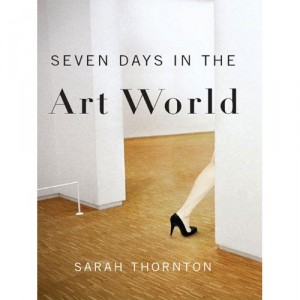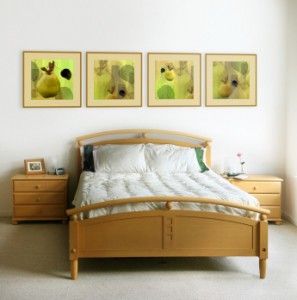 To understand how the markets for creative work are changing, it’s important to understand what the markets were like a few years ago, before technology really starting speeding things up and the economy sent things spiraling down again.
To understand how the markets for creative work are changing, it’s important to understand what the markets were like a few years ago, before technology really starting speeding things up and the economy sent things spiraling down again.
So I read Sarah Thornton’s book “Seven Days in the Art World” to learn what was happening in 2008, when the contemporary art market was booming and prices at auction were going through the roof. Thornton’s book is interesting for several reasons. Although she has a BA in Art History, Thornton also has a PhD in cultural sociology. She observes the “art world” more from the detached, objective perspective of a culture researcher.
The book was compiled from hundreds of hours of “participant observation” and 250 in-depth interviews with high-profile artists, dealers, curators, critics, collectors, and auction-house experts. The seven days refer to insights she gained from observing interactions and activities at seven different sites:
- a Christie’s art auction in Manhattan
- a peer-critique by art students at the California Institute of the Arts
- the Basel Art Fair in Switzerland
- the Tate Britain Museum during the selection of the Turner Prize winner
- the offices of Artforum magazine in New York;
- the studios of artist Takashi Murakami in Tokyo; and
- the pavilions of some of the nations represented at the Venice Biennale.
Each of the seven chapters reads like a Vanity Fair magazine feature story because she reports conversations and observations as they happen. Her approach lets you see how selling and buying art differs from selling other high-value products. (Sometimes, it doesn’t.) Thornton admits that “The art world is so diverse, opaque, and downright secretive, it is difficult to generalize about it and impossible to be truly comprehensive.”
In the book’s introduction, Thornton says when she studied art history, she was exposed to recently made art but “I never had a clear idea of how it circulated, how it came to be considered worthy of critical attention or gained exposure, how it was marketed, sold, or collected.” As the work of living artists have become more in demand, she believes it is worth understanding the valuation processes art undergoes between the studio and its arrival in the permanent collection of a museum (or the trash and anywhere in between).
She differentiates between the “art market” (the dealers, auction houses, and collectors who buy and sell art) and the much broader “art world” which also includes the artists themselves, critics, and curators.
To me, Chapter 1 was the most fascinating because she observes an auction at Christie’s at which some pieces sold for millions of dollars. Here’s a quick overview of observations gleaned from the book about the roles of key players in the art market.
Collectors
People collect art for different reasons. Some truly understand how art can enrich their lives. Others may simply want to diversify their investment portfolios or buy entry in a glamorous lifestyle. Collectors who buy art as investment or because “it’s cool” tend to have changing tastes and aren’t as concerned with the lasting appeal of the art. So they rotate their collections like people buy and sell stock. Collectors who buy for the love of the art tend to form emotional attachments, and only sell due to misfortunes such as death, divorce, or debt. Some collectors hire consultants to advise them.
Auction Houses
Auctions aim to bring the highest prices possible, and provide the illusion of liquidity. Although auction houses want buyers to be confident that they will be able to resell the high-value art they purchase today, that may not always be true. During the boom years, art auctions became something of a high-society spectator sport in which super-successful alpha males mostly competed with other alpha males.
Artists are discouraged from attending auctions because many buying considerations have little to do with the artistic merit. Feel-good paintings with blues or reds tend to sell better than glum paintings with browns or grays. Paintings by male artists tend to attract higher prices because the male collectors tend to better relate to some of the themes. Any works larger than the size of a Park Avenue elevator eliminates a portion of the market.
Primary Dealers
Their role is to represent artists and mount exhibitions of work fresh out of the studio. A primary dealer can try to increase the value of an artist’s work by offering it first to collectors with sterling reputations. The hands through which an artwork passes can help it accrue value.
Secondary Dealers
These dealers don’t work a lot with the artists, but they do work with the auction houses. They have sufficient capital to buy market-tested art without any immediate pressure to resell it. They take control of the object and can hold on to it as long as necessary. So if a certain style of art goes out of favor, they can wait to sell it when that type of art is back in style.
Artists
Artists are discouraged from learning about business and art marketing, because this knowledge can affect the purity of the art-making process. However, the artists who sell well at auction tend to be artist-entrepreneurs. As one commentator in Thornton’s book suggested, perhaps the successful businessmen who buy at auctions admire the boldness and risk-taking of artist-entrepreneurs. The collectors see themselves reflected in the artist-entrepreneurs.
For example, Andy Warhol and Damien Hirst both maintained media profiles that helped increase the audiences for their work. They used production strategies to ensure that a sufficient supply of their art would be available to meet the demands.
When Damien Hirst became the first artist to openly consign work to an auction house, he not only earned international press coverage, but also the admiration of the auction-house personnel who liked his strong work ethic and keen business sense. In general selling work at auction can be risky for an artist’s career, because the prices can fluctuate dramatically from year to year as tastes (and economic conditions) change.
Collectors like meeting the artists whose work they own. But auction houses regard artists as being hard to work with. During the boom, there was a shortage of older works and a spike In demand for fresh, young art. Although auction houses tried not to interfere with the work of dealers, the amount of time between when a work left a studio and hit the resale market became shorter.
What’s Next?
Reading “Seven Days in the Art World” provides a big-picture overview of the art world as it existed in 2008. It can provide a baseline for observing what has happened since the economy tanked, and speculating what might happen next as the base of art collectors continues to expand, both globally and within younger generations.
For example, some training programs have been developed to encourage artists to become more entrepreneurial so they make a living and pay off the student loans from attending art school. And online galleries, art fairs, and social networking are starting to affect the way art is discovered and collectors interact with dealers and artists.
These are some of the questions we’ll continue to examine on this blog. If you have expertise, ideas, or insights that could help artists benefit from some of these ongoing changes in the art market, we would love to hear from you!
 Once the request is submitted, Zatista works with the buyer and artist to ensure that the quoting and payment processes go smoothly. For example, they help the buyer create a well-formed request with all the relevant details, and craft a commission agreement that both the buyer and artist can accept. Buyers aren’t charged for submitting commission requests. Nor are they obligated to accept the quote or follow through with the project.
Once the request is submitted, Zatista works with the buyer and artist to ensure that the quoting and payment processes go smoothly. For example, they help the buyer create a well-formed request with all the relevant details, and craft a commission agreement that both the buyer and artist can accept. Buyers aren’t charged for submitting commission requests. Nor are they obligated to accept the quote or follow through with the project.


